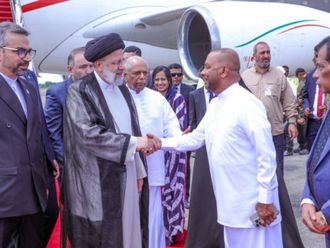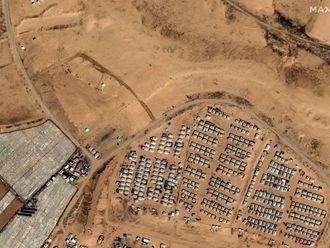Baidoa, Somalia: Mardada Hussain stood outside the beehive-shaped shelter where she sleeps with her eight children and counted everything she had lost. “Ten,” she said. “Ten months here. Three years since we had rain. Fifteen cows, 10 cattle and 20 goats — all dead.”
The arithmetic of catastrophe is written large over Somalia’s interior. But the fatigue etched in Hussain’s face conveys the strain of a double catastrophe of war and drought that has forced millions off the land.
For generations, families like Hussain’s have lived off the land in the Bay region, growing sorghum, a traditional cereal, and raising cattle, camels and goats. Agriculture in this parched landscape has always relied heavily on twice-yearly rains to fill water holes and sustain the vegetation.
Four successive rain failures since 2016 have wiped out herds and destroyed crops across the country, driving more than 2.1 million people, including Hussain’s family, into camps and shanty towns outside the main cities. Humanitarian organisations credit a massive international effort and the work of newly established federal state governments here with averting a seemingly inevitable famine in 2017.
But although patchy rains broke the worst of the drought in autumn, the emergency is far from over.
Famine warning system
The Famine Early Warning Systems Network, which monitors drought impacts, warned last week that 2.7 million people still face food crisis and emergency in Somalia this year. About 301,000 children are suffering from acute malnutrition.
“We need to sustain this response at least through 2018 at the same level. But the concern among humanitarians is that Somalia fatigue will set in,” said Ebrahim Abdullah, emergency operations team leader for Care International in Somalia.
“With a lot of competing needs around the world it might be forgotten,” he added. “But Somalia is still there and the needs are still high.”
The number of internally displaced people more than doubled from one million in the past year, and in Baidoa, the interim capital of both the historic Bay region and an entirely new federal entity called South West State, the IDP (Internally Displaced Persons) camps keep growing. A quarter of a million people are now living in a sea of dome-shaped shelters, hand built out of twigs, tarpaulin and corrugated tin, on the town’s outskirts. “Right now there are 315 IDP settlements,” said Abdullahi Ali Watur, the acting mayor of Baidoa. “In November, there were 261. It’s just getting bigger and bigger.”
Mrs Hussain and her family left their home village of Aliyow Maryle, 45 kilometres away, after the last of their animals died last spring.
For the past 10 months they have lived like most others — crammed into a flimsy, hand-built shelter that offers shade from the sun but not much else in the way of protection.
Interconnecting camps
A vast series of interconnecting camps strung out along the main highway on the south-west edge of town are claustrophobic, disease-ridden and insecure — especially for the women. A spate of sexual assaults has been curtailed since police were posted inside the camps, said Lieutenant Farhia Ahmad Moheid, the commander of the federal police’s gender crime unit in the town.
But she says gangs of men continue to target women when they head into the woods to gather firewood to sell in town — the only option many have to gather enough money to buy rice or millet to feed the family.
The first stop for many new arrivals — especially children and breast feeding mothers — is the city hospital’s specialist wing for treating malnutrition and dehydration.
The facility has saved dozens of lives — but city authorities frankly admit they lack the infrastructure to cope with the sudden appearance of what is, in effect, a new suburb that has doubled the city’s population.
“The people here are suffering. There’s no food. There’s a lack of medicine. A lack of building materials,” said Maalim Hussain Adbdi Maalim, an IDP who has been living in the camp for a year and was elected by one section of the camp to be their advocate to the city authorities and humanitarian organisations.
Logistical challenges
A large relief operation involving the South West Region government, the United Nations, and several foreign and local NGOs is under way, but it is seriously constrained by security and logistical challenges. The only source of fresh water for most of the 250,000 people here is a borehole on the other side of town.
“It needs to be said quickly and clearly that there is a water crisis in Baidoa. There at least 305 camps around the town, and only 37 currently receive water,” acknowledged one local UN aid official, who spoke on condition of anonymity. “The short-term solution is water trucking, but that’s too expensive. And the long-term solution is drilling boreholes — also too expensive.”
It is a Catch-22 deeply entangled with the ongoing war here. The Al Shabab terrorist group cut the road between Baidoa and Mogadishu six months ago. In the meantime, the aid effort is constrained to what can be landed on the city’s crumbling, airstrip. Heavy equipment, like that needed for drilling boreholes, will have to wait for a road convoy.
The war has exacerbated the crisis in other ways. In 2011, when Baidoa was held by Al Shabab, the city was the epicentre of a famine that killed at least 260,000 people, largely because the group refused to allow international aid into its territory. Today, the city is an island of government control and has formed a crucial hub for humanitarian relief — one major reason a repeat of the 2011 famine has been averted. But Al Shabab still controls most of the countryside and has warned humanitarian groups not to operate in its territory. It has also taken to levying taxes to fund its war against the Somali Federal Government and its African Union allies.
High cost of licence
“They demand 400,000 Somali shillings for a licence to farm your own land. If you can’t pay, you’re not allowed to farm,” said one man at the Baidoa camp who asked not to be named. It is not just Al Shabab who are looking for payment. Many IDPs have settled on private land, leading to disputes that in some case have spiralled into controversial eviction operations condemned by human rights groups.
Human Rights Watch said in a report published this week that Somali security forces dismantled or destroyed about 3,000 shelters in makeshift camps in Mogadishu between December and January.
A separate assessment cited by the group said more than 5,000 huts had been destroyed and 38,000 people left homeless by the evictions. The Somali federal government has promised an investigation. Authorities in Baidoa told The Sunday Telegraph that no similar mass evictions had occurred in that city. However, one woman said families have been ordered to pay $2 a month or face eviction — a sum most struggle to raise by selling firewood. The matter of rent and evictions is a sensitive one because, as aid agencies and local government officials here acknowledge, the massive movement of people seen in the past two years is likely to become permanent. “In principle, these people are only staying until it is safe enough to go home,” said Mr Watur. “But they can’t go as long as Al Shabab are still there.” Normality still seems a long way off. Although some rain fell last autumn, it began late, ended early, and only fell haphazardly. The next rainy season, in April and June, is also forecast to be below average. The river bed that runs through Baidoa remains bone dry, and the mud fields where Hussain and her children have built their shelter are baked hard and dusty. “Unless all this changes, there is no way we can go back,” said Mrs Hussain. “We’re stuck.”












